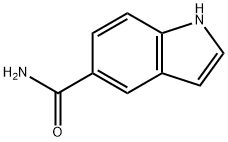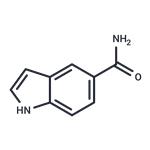Uses
1H-Indole-5-carboxamide (SD-169) is a p38α MAPK-selective inhibitor. 1H-Indole-5-carboxamide (SD-169) prevents the development and progression of diabetes in nonobese diabetic (NOD) mice by inhibiting T cell infiltration and activation.
Uses
SD 169 is a selective ATP competitive inhibitor of the MAP kinases p38α (IC50 = 3.2 nM) and p38β (IC50 = 122 nM). It has no inhibitory effect against a panel of other kinases, including p38γ MAP kinase, ERK2, JNK-1, and MAPKAPK-2, when tested in vitro at 50 μM. SD 169 is orally active, significantly reducing p38 MAP kinase expression in T cells of nonobese diabetic mice when delivered in chow at 600 mg/kg. In this model, SD 169 also reduced the incidence of diabetes, lowered blood glucose, and improved glucose homeostasis. SD 169 also enhances axonal regeneration after sciatic nerve crush injury in rats, when given by gavage (30 mg/kg) before and after nerve damage.
Definition
ChEBI: 1H-indole-5-carboxamide is an indolecarboxamide.
Biological Activity
Selective, orally active, ATP-competitive inhibitor of p38 α MAPK (IC 50 values are 3.2, 122 and > 50000 nM for p38 α , p38 β and p38 γ respectively). Demonstrates no activity against a range of other kinases including ERK2, JNK1 and MAPKAP2. Prevents development of diabetes and alleviates mild and moderate hyperglycaemic states in NOD mice.
References
[1] medicherla s, protter a a, ma j y, et al. preventive and therapeutic potential of p38α-selective mitogen-activated protein kinase inhibitor in nonobese diabetic mice with type 1 diabetes[j]. journal of pharmacology and experimental therapeutics, 2006, 318(1): 99-107.
[2] myers r r, sekiguchi y, kikuchi s, et al. inhibition of p38 map kinase activity enhances axonal regeneration[j]. experimental neurology, 2003, 184(2): 606-614.




